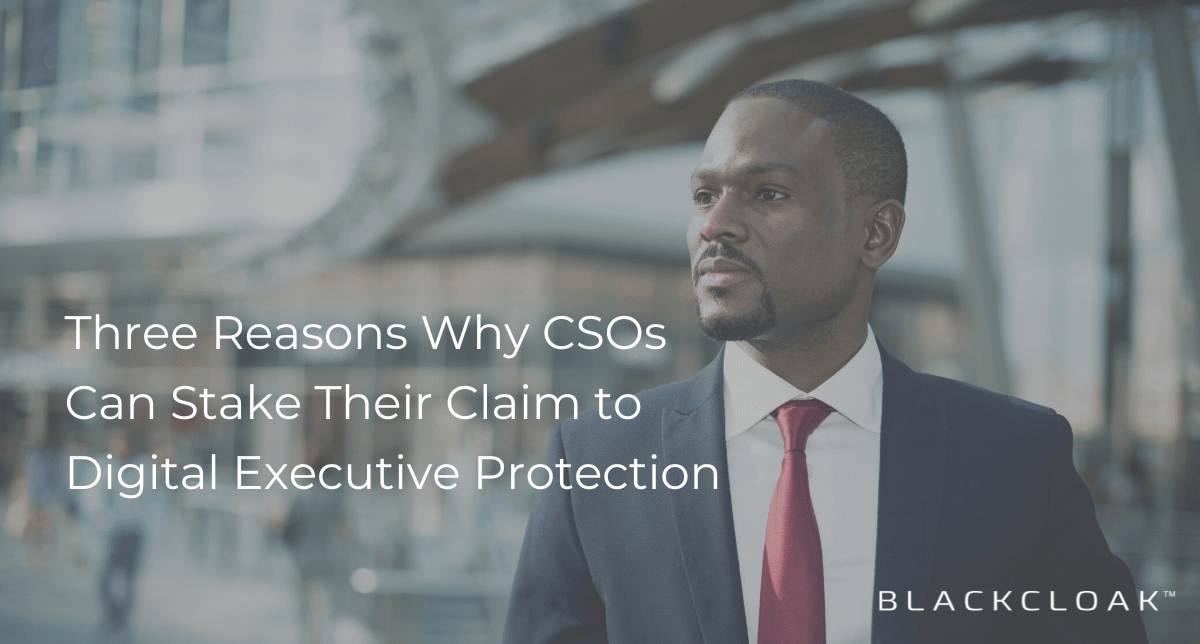Three Reasons Why CSOs Can Stake Their Claim to Digital Executive Protection

We’ve previously written about who owns digital executive protection for the long haul? Is it the Chief Information Officer (CISO) or the Chief Security Officer (CSO)?
You might think that the CISO, who is responsible for all things digital protection, is the natural fit for the role. But as the lines between the physical and digital world soften and an executive’s digital footprint poses increased physical risk, the CSO also has a stake in the game.
The debate is ongoing and CISOs often pushback, citing several reasons why CSOs (who traditionally have purview over physical protection) should not take the lead on digital executive protection.
For instance, the CISO and their team might argue that they are already familiar with digital threats and protection, so it’s best to keep the responsibility with them. They may also claim that only someone with a technology background can ensure that there is no conflict between personal cybersecurity solutions and internal security programs, such as mobile device management (MDM).
Furthermore, digital executive protection involves conducting home network penetration tests – which may raise eyebrows since the CISO would lack visibility into those who perform the tests. Data storage and collection of personal data also presents concern. After all, the CISO is involved in establishing and managing corporate data policies – not the CSO.
And finally, what do CSOs know about digital threats anyway? Would they even know at what point to bring them to the attention of the CISO?
Why CSOs could own digital executive protection
While each of CISOs’ primary concerns are valid, there is a strong case to be made that digital executive protection is the CSO’s responsibility.
Consider the following about CSOs:
- They already have familiarity with the family – First and foremost, to conduct their duties, CSOs already occupy the personal lives of executives and their families – keeping them safe from physical threats at home and on the go. They are known, trusted, and are present without intruding. Their existing connection to the family could make it easier to onboard and manage a digital executive protection solution.
- Deep tech savvy is not necessary – Corporate security teams can be too technical, and overly processed. Cybersecurity is complicated, but digital security teams can struggle to connect with executives and their families if they cannot get past the analysis paralysis and tech jargon. The CSO, by default, breaks through the complications and gets to work. They can do this because they have the advantage of being on the outside already (unlike the CISO who’s remit and focus is “corporate”). This allows them to apply their critical thinking skills, get to the crux of the problem quickly, act fast to mitigate digital threats, and have the cooperation from families who may not be technically inclined.
- They understand how digital impacts physical (and vice versa) – Finally, CSOs recognize that executives’ physical and digital worlds collide. They know that if an executive’s personal email is hacked and their travel schedule is revealed that their physical safety can be compromised, too. And because the executive’s personal digital life is not protected by the cloak of corporate protection, they also understand that the CISO can’t always provide the expert support that executives need in the event of a protracted attack.
CSOs protect executives in their corporate and professional physical activities. BlackCloak extends this same level of protection to their personal digital lives – protecting executives’ cybersecurity and personal privacy, wherever, whenever.
The convergence of physical and digital security calls for a collaborative response
The reality is that whoever owns digital executive protection will vary from company to company – but it will require collaboration between physical and digital security teams like never before.
As the lines between personal and work life have all but completely blurred, pigeonholing executive protection outside the workplace to one group or another will not lead to the best results. That’s why BlackCloak works with both CISOs and CSOs – and their teams – to implement a digital executive protection plan that meets their organization’s unique and evolving needs.
Contact us today to learn more about how we fill the gap that exists between physical and digital security teams.









